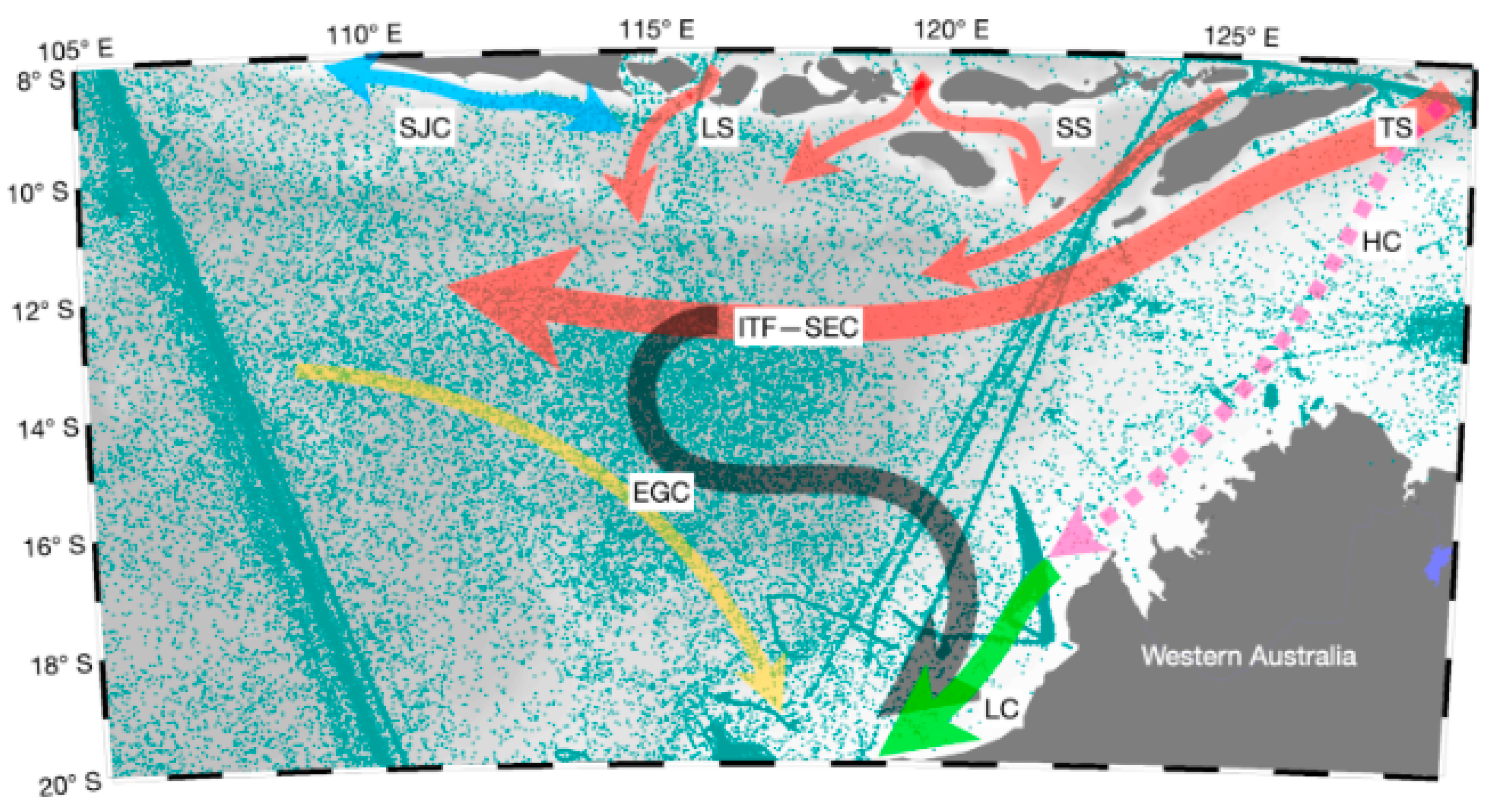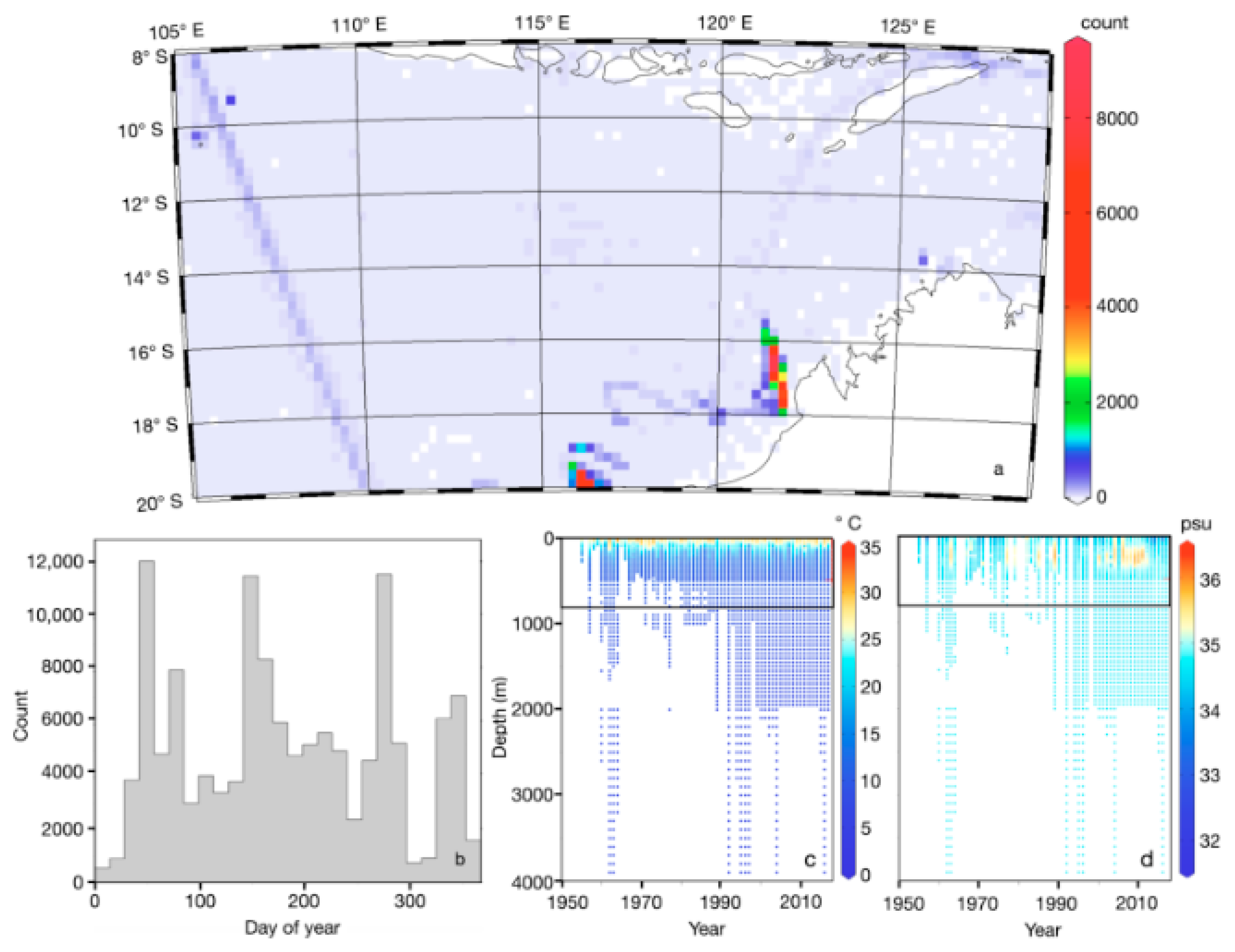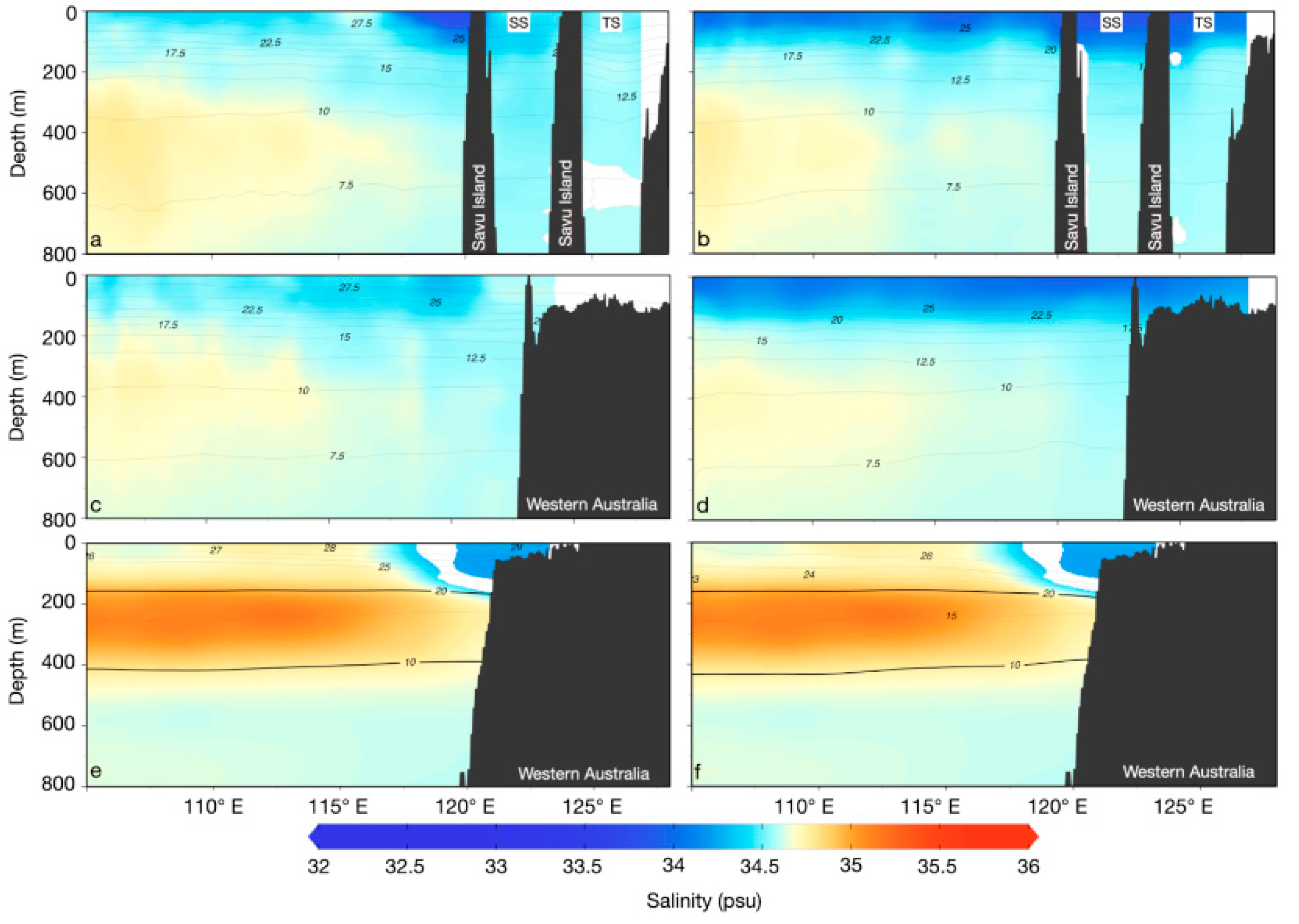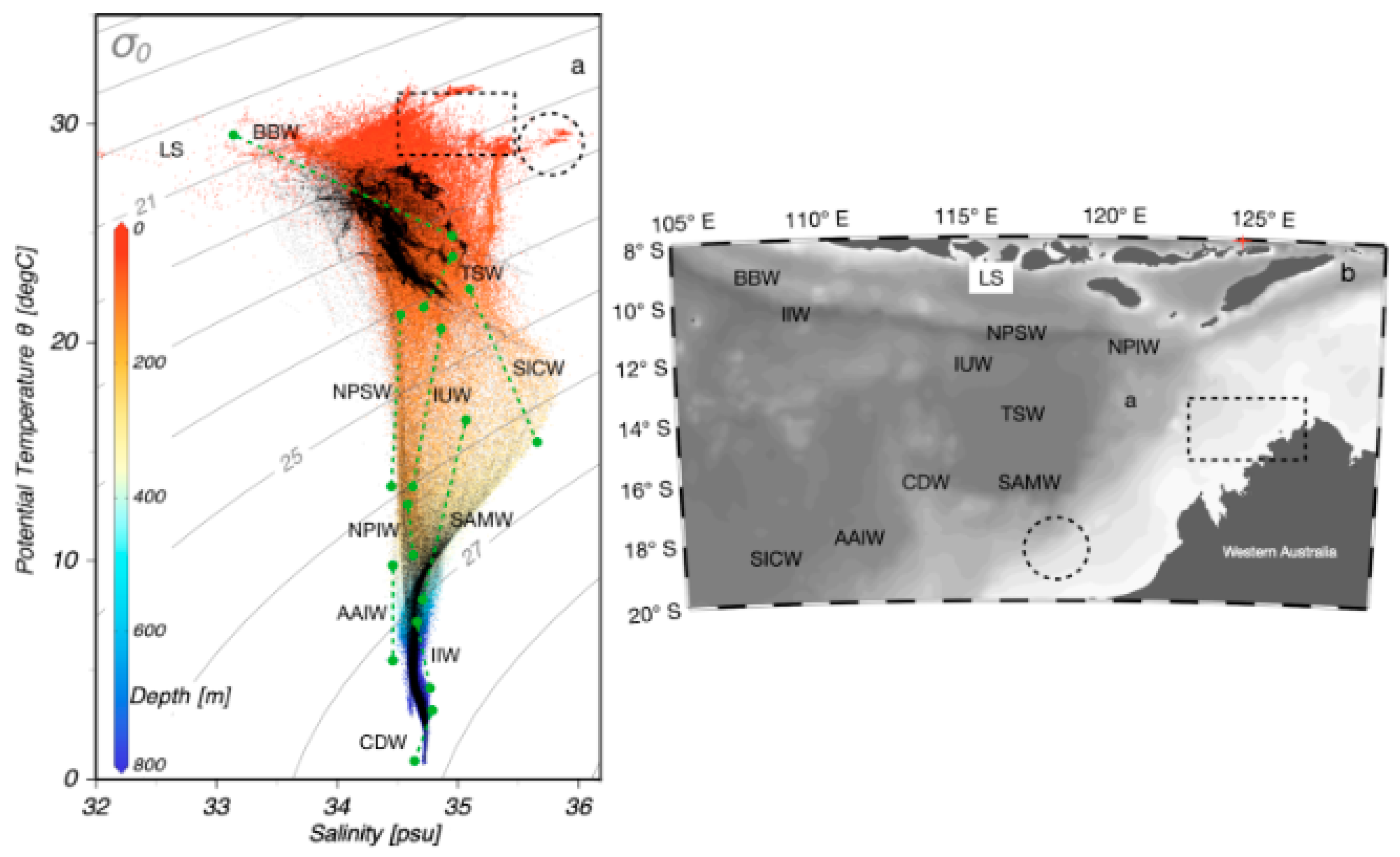Seasonal Water Mass Transformation in the Eastern Indian Ocean from In Situ Observations
Abstract
:1. Introduction
2. Materials and Methods
2.1. Geographical Areas
2.2. Datasets
2.3. Data Analysis
3. Results
3.1. Seasonal T-S Variation
3.2. Water Mass Structures
3.3. Water Column Stability
4. Discussion
5. Future Challenges
6. Conclusions
Author Contributions
Funding
Institutional Review Board Statement
Informed Consent Statement
Data Availability Statement
Acknowledgments
Conflicts of Interest
References
- Kämpf, J.; Chapman, P. Upwelling Systems of the World: A Scientific Journey to the Most Productive Marine Ecosystems; Springer Science and Business Media LLC: Dordrecht, The Netherlands, 2016. [Google Scholar] [CrossRef]
- Utamy, R.M.; Purba, N.P.; Pranowo, W.S.; Suherman, H. The Pattern of South Equatorial Current and Primary Productivity in South Java Seas Rizky. In Proceedings of the 2015 5th International Conference on Environment Science and Biotechnology (ICESB 2015), Jinju, Republic of Korea, 9–10 November 2015; Volume 51, pp. 139–142. [Google Scholar] [CrossRef]
- Tussadiah, A.; Syamsuddin, M.L.; Pranowo, W.S.; Purba, N.P.; Riyantini, I. Eddy Vertical Structure in Southern Java Indian Ocean: Identification using Automated Eddies Detection. Int. J. Sci. Res. 2016, 5, 967–971. [Google Scholar]
- Sprintall, J.; Gordon, A.L.; Wijffels, S.E.; Feng, M.; Hu, S.; Koch-Larrouy, A.; Phillips, H.; Nugroho, D.; Napitu, A.; Pujiana, K.; et al. Detecting change in the Indonesian seas. Front. Mar. Sci. 2019, 6, 257. [Google Scholar] [CrossRef]
- Fan, W.; Jian, Z.; Chu, Z.; Dang, H.; Wang, Y.; Bassinot, F.; Han, X.; Bian, Y. Variability of the Indonesian Throughflow in the Makassar Strait over the Last 30 ka. Sci. Rep. 2018, 8, 5678. [Google Scholar] [CrossRef] [PubMed]
- Yuliardi, A.Y.; Atmadipoera, A.S.; Harsono, G.; Natih, N.M.N.; Ando, K. Analysis of characteristics and turbulent mixing of seawater mass in lombok strait. Ilmu Kelaut. 2021, 26, 95–109. [Google Scholar] [CrossRef]
- Atmadipoera, A.; Molcard, R.; Madec, G.; Wijffels, S.; Sprintall, J.; Koch-Larrouy, A.; Jaya, I.; Supangat, A. Characteristics and variability of the Indonesian throughflow water at the outflow straits. Deep. Sea Res. Part I Oceanogr. Res. Pap. 2009, 56, 1942–1954. [Google Scholar] [CrossRef]
- Song, Q.; Gordon, A.L.; Visbeck, M. Spreading of the Indonesian throughflow in the Indian Ocean. J. Phys. Oceanogr. 2004, 34, 772–792. [Google Scholar] [CrossRef]
- Sprintall, J.; Wijffels, S.E.; Molcard, R.; Jaya, I. Direct estimates of the Indonesian throughflow entering the Indian ocean: 2004–2006. J. Geophys. Res. Oceans 2009, 114, 2004–2006. [Google Scholar] [CrossRef]
- Sani, I.Y.; Atmadipoera, A.S.; Purwandana, A.; Syamsudin, F. Transformation and mixing of North Pacific Water Mass in Sangihe-Talaud in August 2019. In IOP Conference Series: Earth and Environmental Science; IOP Publishing Ltd.: Bristol, UK, 2021; Volume 944, p. 012053. [Google Scholar] [CrossRef]
- Feng, M.; Zhang, N.; Liu, Q.; Wijffels, S. The Indonesian throughflow, its variability and centennial change. Geosci. Lett. 2018, 5, 3. [Google Scholar] [CrossRef]
- Woo, M.; Pattiaratchi, C. Hydrography and water masses off the western Australian coast. Deep. Sea Res. Part I Oceanogr. Res. Pap. 2008, 55, 1090–1104. [Google Scholar] [CrossRef]
- Tillinger, D.; Gordon, A.L. Fifty years of the Indonesian throughflow. J. Clim. 2009, 22, 6342–6355. [Google Scholar] [CrossRef]
- D’Adamo, N.; Fandry, C.; Buchan, S.; Domingues, C. Northern sources of the Leeuwin Current and the ‘Holloway Current’ on the North West Shelf. J. R. Soc. West. Aust. 2009, 92, 53–66. [Google Scholar]
- Nof, D.; Pichevin, T.; Sprintall, J. ‘Teddies’ and the origin of the Leeuwin current. J. Phys. Oceanogr. 2002, 32, 2571–2588. [Google Scholar] [CrossRef]
- Wijffels, S.; Sprintall, J.; Fieux, M.; Bray, N. The JADE and WOCE I10/IR6 Throughflow sections in the southeast indian ocean. Part 1: Water mass distribution and variability. Deep. Sea Res. Part II Top. Stud. Oceanogr. 2002, 49, 1341–1362. [Google Scholar] [CrossRef]
- Auer, G.; De Vleeschouwer, D.; Smith, R.A.; Bogus, K.; Groeneveld, J.; Grunert, P.; Castañeda, I.S.; Petrick, B.; Christensen, B.; Fulthorpe, C.; et al. Timing and Pacing of Indonesian Throughflow Restriction and Its Connection to Late Pliocene Climate Shifts. Paleoceanogr. Paleoclimatol. 2019, 34, 635–657. [Google Scholar] [CrossRef]
- Feng, X.; Liu, H.L.; Wang, F.C.; Yu, Y.Q.; Yuan, D.L. Indonesian Throughflow in an eddy-resolving ocean model. Chin. Sci. Bull. 2013, 58, 4504–4514. [Google Scholar] [CrossRef]
- Silveira, T.M.; Carapuço, M.M.; Miranda, J.M. The Ever-Changing and Challenging Role of Ocean Observation: From Local Initiatives to an Oceanwide Collaborative Effort. Front. Mar. Sci. 2022, 8, 778452. [Google Scholar] [CrossRef]
- Makarim, S.; Sprintall, J.; Liu, Z.; Yu, W.; Santoso, A.; Yan, X.-H.; Susanto, R.D. Previously unidentified Indonesian Throughflow pathways and freshening in the Indian Ocean during recent decades. Sci. Rep. 2019, 9, 7364. [Google Scholar] [CrossRef]
- Levitus, S.; Antonov, J.I.; Baranova, O.K.; Boyer, T.P.; Coleman, C.L.; Garcia, H.E.; Grodsky, A.I.; Johnson, D.R.; Locarnini, R.A.; Mishonov, A.V.; et al. The world ocean database. Data Sci. J. 2013, 12, WDS229–WDS234. [Google Scholar] [CrossRef]
- Zweng, M.M.; Boyer, T.P.; Baranova, O.K.; Reagan, J.R.; Seidov, D.; Smolyar, I.V. An inventory of Arctic Ocean data in the World Ocean Database. Earth Syst. Sci. Data 2018, 10, 677–687. [Google Scholar] [CrossRef]
- Johari, A.; Akhir, M.F. Exploring Thermocline and Water Masses Variability in Southern South Cina Sea from The World Ocean Datbase (WOD). Acta Oceanol. Sin. 2019, 38, 38–47. [Google Scholar] [CrossRef]
- Chu, P.C.; Margolina, T.; Rodriguez, D.A.; Fan, C.; Ivanov, L.M. Spatial and temporal variability of the California Current identified from the synoptic monthly gridded World Ocean Database (WOD). Deep. Sea Res. Part II Top. Stud. Oceanogr. 2018, 151, 37–48. [Google Scholar] [CrossRef]
- Purwandana, A.; Cuypers, Y.; Bouruet-Aubertot, P.; Nagai, T.; Hibiya, T.; Atmadipoera, A.S. Spatial structure of turbulent mixing inferred from historical CTD datasets in the Indonesian seas. Prog. Oceanogr. 2020, 184, 102312. [Google Scholar] [CrossRef]
- Lambert, E.; Le Bars, D.; De Ruijter, W.P.M. The connection of the Indonesian Throughflow, South Indian Ocean Countercurrent and the Leeuwin Current. Ocean. Sci. 2016, 12, 771–780. [Google Scholar] [CrossRef]
- Tintoré, J.; Pinardi, N.; Álvarez-Fanjul, E.; Aguiar, E.; Álvarez-Berastegui, D.; Bajo, M.; Balbin, R.; Bozzano, R.; Nardelli, B.B.; Cardin, V.; et al. Challenges for Sustained Observing and Forecasting Systems in the Mediterranean Sea. Front. Mar. Sci. 2019, 6, 568. [Google Scholar] [CrossRef]
- Domingues, C.M.; Maltrud, M.E.; Wijffels, S.E.; Church, J.A.; Tomczak, M. Simulated Lagrangian pathways between the Leeuwin Current System and the upper-ocean circulation of the southeast Indian Ocean. Deep. Sea Res. Part II Top. Stud. Oceanogr. 2007, 54, 797–817. [Google Scholar] [CrossRef]
- Gordon, A.L. Oceanography of the Indonesian Seas and Their Throughflow. Oceanography 2005, 18, 14–27. [Google Scholar] [CrossRef]
- Utari, P.A.; Setiabudidaya, D.; Khakim, M.Y.N.; Iskandar, I. Dynamics of the South Java Coastal Current revealed by RAMA observing network. Terr. Atmos. Ocean. Sci. 2019, 30, 235–245. [Google Scholar] [CrossRef]
- Boyer, T.P.; Baranova, O.K.; Coleman, C.; Garcia, H.E.; Grodsky, A.; Locarnini, R.A.; Mishonov, A.V.; Paver, C.R.; Reagan, J.R.; Seidov, D.; et al. NOAA Atlas NESDIS 87. World Ocean Database 2018, 2018, 1–207. [Google Scholar]
- Parks, J.; Bringas, F.; Cowley, R.; Hanstein, C.; Krummel, L.; Sprintall, J.; Cheng, L.; Cirano, M.; Cruz, S.; Goes, M.; et al. XBT operational best practices for quality assurance. Front. Mar. Sci. 2022, 9, 991760. [Google Scholar] [CrossRef]
- Purba, N.P.; Pranowo, W.S.; Ndah, A.B.; Nanlohy, P. Seasonal variability of temperature, salinity, and surface currents at 0° latitude section of Indonesia seas. Reg. Stud. Mar. Sci. 2021, 44, 101772. [Google Scholar] [CrossRef]
- Cheng, L.; Zhu, J.; Cowley, R.; Boyer, T.; Wijffels, S. Time, probe type, and temperature variable bias corrections to historical expendable bathythermograph observations. J. Atmos. Ocean. Technol. 2014, 31, 1793–1825. [Google Scholar] [CrossRef]
- Cheng, L.; Luo, H.; Boyer, T.; Cowley, R.; Abraham, J.; Gouretski, V.; Reseghetti, F.; Zhu, J. How well can we correct systematic errors in historical XBT data? J. Atmos. Ocean. Technol. 2018, 35, 1103–1125. [Google Scholar] [CrossRef]
- Emery, W.J. Oceanographic Topics: Water Types and Water Masses. In Encyclopedia of Atmospheric Sciences, 2nd ed.; Elsevier: Amsterdam, The Netherlands, 2015; pp. 329–337. [Google Scholar] [CrossRef]
- Schlitzer, R. Ocean Data View. 2022. Available online: https://odv.awi.de (accessed on 17 June 2023).
- Emery, W.J.; Lee, W.G.; Magaard, L. Geographic and Seasonal Distributions of Brunt–Väisälä Frequency and Rossby Radii in the North Pacific and North Atlantic. J. Phys. Oceanogr. 1984, 14, 294–317. [Google Scholar] [CrossRef]
- Ferreres, E.; Soler, M.R.; Terradellas, E. Analysis of turbulent exchange and coherent structures in the stable atmospheric boundary layer based on tower observations. Dyn. Atmos. Ocean. 2013, 64, 62–78. [Google Scholar] [CrossRef]
- Jackett, D.R.; McDougall, T.J.; Feistel, R.; Wright, D.G.; Griffies, S.M. Algorithms for density, potential temperature, conservative temperature, and the freezing temperature of seawater. J. Atmos. Ocean. Technol. 2006, 23, 1709–1728. [Google Scholar] [CrossRef]
- Tomczak, M.; Godfrey, J.S. Regional Oceanography: The Indian Ocean. In Regional Oceanography; Pergamon Press: London, UK, 1994; pp. 193–220. [Google Scholar] [CrossRef]
- Gordon, A.L.; Sprintall, J.; Van Aken, H.; Susanto, D.; Wijffels, S.; Molcard, R.; Ffield, A.; Pranowo, W.; Wirasantosa, S. The Indonesian throughflow during 2004–2006 as observed by the INSTANT program. Dyn. Atmos. Ocean. 2010, 50, 115–128. [Google Scholar] [CrossRef]
- Katavouta, A.; Polton, J.A.; Harle, J.D.; Holt, J.T. Effect of Tides on the Indonesian Seas Circulation and Their Role on the Volume, Heat and Salt Transports of the Indonesian Throughflow. J. Geophys. Res. Oceans 2022, 127, e2022JC018524. [Google Scholar] [CrossRef]
- Nuber, S.; Rae, J.W.; Zhang, X.; Andersen, M.B.; Dumont, M.D.; Mithan, H.T.; Sun, Y.; De Boer, B.; Hall, I.R.; Barker, S. Indian Ocean salinity build-up primes deglacial ocean circulation recovery Access options. Nature 2023, 617, 306–311. [Google Scholar] [CrossRef]
- Spooner, M.I.; De Deckker, P.; Barrows, T.T.; Fifield, L.K. The behaviour of the Leeuwin Current offshore NW Australia during the last five glacial-interglacial cycles. Glob. Planet. Chang. 2011, 75, 119–132. [Google Scholar] [CrossRef]
- Woo, M.; Pattiaratchi, M.; Feng, C. Hydrography and water masses in the south-eastern Indian Ocean. Tech. Rep. 2007, 2, 1–36. [Google Scholar] [CrossRef]
- Warren, B.A. Transindian Hydrographic Section At Lat. 18 °S: Property Distributions and Circulation in The South Indian Ocean. Deep. Sea Res. A 1981, 28, 759–788. [Google Scholar] [CrossRef]
- Fieux, M.; Molcard, R.; Morrow, R. Water properties and transport of the Leeuwin Current and Eddies off Western Australia. Deep. Sea Res. Part I Oceanogr. Res. Pap. 2005, 52, 1617–1635. [Google Scholar] [CrossRef]
- Álvarez, M.; Brea, S.; Mercier, H.; Álvarez-Salgado, X.A. Mineralization of biogenic materials in the water masses of the South Atlantic Ocean. I: Assessment and results of an optimum multiparameter analysis. Prog. Oceanogr. 2014, 123, 1–23. [Google Scholar] [CrossRef]
- Sprintall, J.; Chong, J.; Syamsudin, F.; Morawitz, W.; Hautala, S.; Bray, N.; Wijffels, S. Dynamics of the South Java Current in the Indo-Australian Basin. Geophys. Res. Lett. 1999, 26, 2493–2496. [Google Scholar] [CrossRef]
- Levin, L.A. IPCC and the Deep Sea: A Case for Deeper Knowledge. Front. Clim. 2021, 3, 720755. [Google Scholar] [CrossRef]
- Zhou, S.; Meijers, A.J.S.; Meredith, M.P.; Abrahamsen, E.P.; Holland, P.R.; Silvano, A.; Sallée, J.-B.; Østerhus, S. Slowdown of Antarctic Bottom Water export driven by climatic wind and sea-ice changes. Nat. Clim. Chang. 2023, 13, 701–709. [Google Scholar] [CrossRef]
- Messias, M.J.; Mercier, H. The redistribution of anthropogenic excess heat is a key driver of warming in the North Atlantic. Commun. Earth Environ. 2022, 3, 118. [Google Scholar] [CrossRef]
- Chidichimo, M.P.; Perez, R.C.; Speich, S.; Kersalé, M.; Sprintall, J.; Dong, S.; Lamont, T.; Sato, O.T.; Chereskin, T.K.; Hummels, R.; et al. Energetic overturning flows, dynamic interocean exchanges, and ocean warming observed in the South Atlantic. Commun. Earth Environ. 2023, 4, 10. [Google Scholar] [CrossRef]
- Gusviga, B.H.; Subiyanto; Faizal, I.; Yusri, S.; Sari, S.K.; Purba, N.P. Occurrence and Prediction of Coral Bleaching Based on Ocean Surface Temperature Anomalies and Global Warming in Indonesian Waters. IOP Conf. Ser. Earth Environ. Sci. 2021, 750, 012032. [Google Scholar] [CrossRef]







| Casts/Cruises | ||||||||
|---|---|---|---|---|---|---|---|---|
| Instrument | OSD | CTD | XBT | MBT | PFLs | MRBs | SUR | GLD |
| Data count | 25,900 | 12,712 | 66,653 | 41,679 | 47,256 | 54,645 | 431 | 286 |
| Min | Max | Mean | Standard Dev. | |
|---|---|---|---|---|
| Temperature (°C) | 1.160 | 32.425 | 27.340 | 2.546 |
| Salinity (psu) | 30.613 | 36.112 | 34.483 | 0.297 |
| No. | Water Mass | Abbreviation | T-S Characteristics | |
|---|---|---|---|---|
| Temp. (°C) | Sali. (psu) | |||
| 1 | Indonesian Upper Water [6] | IUW | 8.0–23.0 | 34.4–35.0 |
| 2 | Bengal Bay Water [6] | BBW | 25.0–29.0 | 28.0–35.0 |
| 3 | Indonesian Intermediate Water [6] | IIW | 3.5–5.5 | 34.6–34.7 |
| 4 | Antarctic Intermediate Water [6] | AAIW | 4.5–8.5 | 34.4–34.6 |
| 5 | Tropical Surface Water [6] | TSW | 22.0–24.5 | 34.7–35.1 |
| 6 | Subantarctic Mode Water [6] | SAMW | 8.5–12.0 | 34.6–35.1 |
| 7 | Circumpolar Deep Water [6] | CDW | 1.0–2.0 | 34.6–34.7 |
| 8 | South Indian Central Water [6] | SICW | 8.0–25.0 | 34.6–35.8 |
| 9 | North Pacific Intermediate Water [36] | NPIW | 8.8–11.3 | 34.4–34.5 |
| 10 | North Pacific South Water [36] | NPSW | 14.2–21.5 | 34.4–34.5 |
Disclaimer/Publisher’s Note: The statements, opinions and data contained in all publications are solely those of the individual author(s) and contributor(s) and not of MDPI and/or the editor(s). MDPI and/or the editor(s) disclaim responsibility for any injury to people or property resulting from any ideas, methods, instructions or products referred to in the content. |
© 2023 by the authors. Licensee MDPI, Basel, Switzerland. This article is an open access article distributed under the terms and conditions of the Creative Commons Attribution (CC BY) license (https://creativecommons.org/licenses/by/4.0/).
Share and Cite
Purba, N.P.; Akhir, M.F.; Pranowo, W.S.; Subiyanto; Zainol, Z. Seasonal Water Mass Transformation in the Eastern Indian Ocean from In Situ Observations. Atmosphere 2024, 15, 1. https://doi.org/10.3390/atmos15010001
Purba NP, Akhir MF, Pranowo WS, Subiyanto, Zainol Z. Seasonal Water Mass Transformation in the Eastern Indian Ocean from In Situ Observations. Atmosphere. 2024; 15(1):1. https://doi.org/10.3390/atmos15010001
Chicago/Turabian StylePurba, Noir P., Mohd Fadzil Akhir, Widodo S. Pranowo, Subiyanto, and Zuraini Zainol. 2024. "Seasonal Water Mass Transformation in the Eastern Indian Ocean from In Situ Observations" Atmosphere 15, no. 1: 1. https://doi.org/10.3390/atmos15010001
APA StylePurba, N. P., Akhir, M. F., Pranowo, W. S., Subiyanto, & Zainol, Z. (2024). Seasonal Water Mass Transformation in the Eastern Indian Ocean from In Situ Observations. Atmosphere, 15(1), 1. https://doi.org/10.3390/atmos15010001












